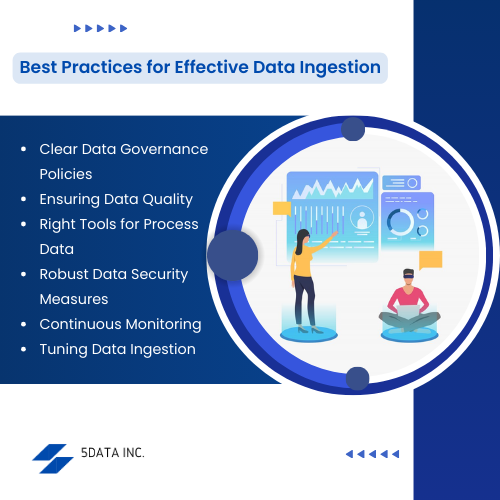Understanding Data Ingestion
At its core, data ingestion is the dynamic process of seamlessly transferring data or information from multiple sources to a designated platform for subsequent analysis and processing. This critical step lays the foundation for constructing a comprehensive data pipeline, facilitating the flow of data from diverse origins such as databases, data lakes, SaaS applications, and IoT devices. Picture it as the inaugural phase in establishing a data pipeline — a mechanism designed for streaming data efficiently throughout its lifecycle. The essence of data ingestion lies in its ability to effortlessly import from various data sources, orchestrating a harmonious integration into a centralized database and data lake. Data ingestion acts as the gateway, ushering in diverse data sources to a designated data warehouse for further exploration and analysis.Unveiling the Advantages of Data Ingestion
The adoption of data ingestion brings forth a myriad of advantages, unlocking insights crucial for understanding markets, customers, product development, and overall business enhancement. The benefits include:Streamlined Automated Data Transfers
Bid farewell to manual data transfers and usher in efficiency with automated data ingestion tools. These tools seamlessly extract, transfer, aggregate data, and store information, freeing up valuable time for more critical tasks.Understanding Core Business Data
Data, whether sourced externally or from your operations, holds untapped potential. Through data ingestion, uncover valuable insights that can propel your business forward. Gain a profound understanding of successful business models, identify market gaps, and strategize effectively. In essence, data ingestion empowers you to turn raw data into actionable business intelligence.Achieving Data Uniformity
Diversity in data is a given, but data ingestion ensures harmonization. Regardless of the unstructured data from multiple sources, the tool helps to analyze data, creating a cohesive dataset. This uniform dataset becomes a valuable resource for generating reports, conducting analytics, and fueling business intelligence initiatives.Risks of Neglecting Data Ingestion Steps
Data ingestion encompasses critical steps, including duplicate data identification, data collection, data preparation, data aggregation, data integration, and security. Skipping any of these steps can introduce several risks:Excessive API Usage
By bypassing essential data ingestion best practices such as caching and batch processing, you may inadvertently increase API calls. It increases database workload and escalates costs, as frequent API calls demand additional data warehouses.Schema Drift
Inaccurate execution of data ingestion steps can lead to schema drift, causing the data structure to change over time. These pose a challenge in maintaining data quality and consistency, negatively impacting analytics projects and inflating operational costs.Escalating Costs
Skipping crucial data ingestion steps like duplication and data cleansing can result in poor-quality data. Storing duplicate records contributes to increased data storage system costs. Delaying data cleansing until later in the pipeline disrupts operations, consumes time, and introduces unnecessary chaos. Ingest data to mitigate these risks, ensuring a streamlined process that enhances data processing, consistency, and overall operational efficiency. Navigate the entire life cycle of your data with expert precision through comprehensive Data Life Cycle Management Services.Types of Data Ingestion
Batch Processing
Batch data ingestion involves collecting data over a defined period and processing it in a single batch. Ideal for non-real-time tasks, it minimizes system impact by running during off-peak hours. Examples include daily sales reports and monthly financial statements. While reliable, it may not suit modern applications requiring real-time updates, such as fraud detection or stock trading platforms.Real-Time Processing
Real-time processing ingests information as it’s generated, allowing immediate data analysis. Suited for time-sensitive applications like monitoring systems and IoT applications, it demands significant computing power and network bandwidth. Sophisticated data engineering is necessary to manage the continuous flow of data.Micro-Batching
Micro-batching merges elements of batch and real-time processing, importing data in small, frequent batches. Balancing timely updates without the resource demands of real-time processing it’s a compromise for businesses needing agility without full-scale real-time processing.The Data Ingestion Process
Step 1: Data Discovery
Identify, understand, and aggregate from multiple data sources to establish a clear understanding of the data engineering, including its structure, quality, and potential for usage.Step 2: Data Acquisition
Data access from diverse sources, ranging from databases to paper documents, ensures data integrity despite challenges like different formats and large volumes.Step 3: Data Validation
Check acquired data for accuracy and consistency through measures such as data type validation, range validation, and uniqueness validation to ensure reliability.Step 4: Data Transformation
Utilize various data ingestion tools to convert validated data into a format suitable for analysis and processing, involving steps like normalization, aggregation, and standardization.Step 5: Data Loading
Load transformed data into a data warehouse or desired destination, either in batch or real-time, making it ready for decision-making and generating insights. Empower your data strategy with top-tier Data Management Service Providers, ensuring seamless organization and optimization.
Best Practices for Effective Data Ingestion
Defining Clear Data Governance Policies
Establish best practices for data availability, usability, integrity, and security, preventing data-related issues and conflicts.Ensuring Data Quality at the Initial Phase
Ensure data accuracy, consistency, and reliability at the point of collection to save resources and time that would otherwise be spent on analyzing data and validation.Using the Right Tools for the Process Data
Leverage tools to streamline and automate the data ingestion process, reducing time and effort and improving accuracy and reliability.Implementing Robust Data Security Measures
Protect data from unauthorized access and potential threats through comprehensive measures like data encryption, access control, and network security.Continuously Monitoring and Tuning the Data Ingestion Process
Keep a close eye on the cloud data warehouses, identifying and resolving issues promptly to maintain a smooth ingesting of data processing.Conclusion
In conclusion, effective data ingestion is foundational to unlocking the power of data for informed decision-making. By understanding and implementing diverse data ingestion methods, adhering to a structured process, and embracing best practices, organizations can utilize their data to its full potential. Whether through batch processing, real-time updates, or a balanced micro-batching approach, the key lies in ensuring data quality, security, and continuous optimization. Harvest insights effortlessly with precision-driven Data Collection strategies tailored to your business needs.
About the Author...
Almaas Saleem is a skilled software engineer from Kerala, India who currently resides in East Africa. She is passionate about technology and constantly seeks to learn more about it through reading and hands-on experience. Almaas excels in web development, design, automated testing software, ethical hacking, cybersecurity, and digital marketing. She also works as a technical writer for new businesses, managing various entities. Almaas is distinguished by her steadfastness and commitment to her work, which consistently yields excellent results.
